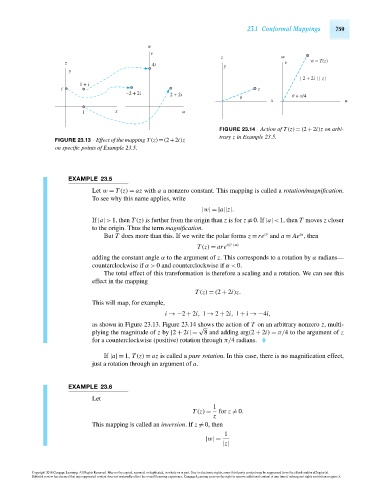Page 779 - Advanced_Engineering_Mathematics o'neil
P. 779
23.1 Conformal Mappings 759
w
v
z w
z 4i y v w = T(z)
y
2 + 2i z
1 + i
i z
−2 + 2i 2 + 2i
θ θ + π/4
x u
1 x u
FIGURE 23.14 Action of T(z) = (2 + 2i)zon arbi-
trary z in Example 23.5.
FIGURE 23.13 Effect of the mapping T (z)=(2+2i)z
on specific points of Example 23.5.
EXAMPLE 23.5
Let w = T (z) = az with a a nonzero constant. This mapping is called a rotation/magnification.
To see why this name applies, write
|w|=|a||z|.
If |a|>1, then T (z) is further from the origin than z is for z =0. If |a|<1, then T moves z closer
to the origin. Thus the term magnification.
But T does more than this. If we write the polar forms z =re and a = Ae , then
iα
iθ
T (z) = are i(θ+α)
adding the constant angle α to the argument of z. This corresponds to a rotation by α radians—
counterclockwise if α> 0 and counterclockwise if α< 0.
The total effect of this transformation is therefore a scaling and a rotation. We can see this
effect in the mapping
T (z) = (2 + 2i)z.
This will map, for example,
i →−2 + 2i, 1 → 2 + 2i, 1 + i →−4i,
as shown in Figure 23.13. Figure 23.14 shows the action of T on an arbitrary nonzero z, multi-
√
plying the magnitude of z by |2 + 2i|= 8 and adding arg(2 + 2i) = π/4 to the argument of z
for a counterclockwise (positive) rotation through π/4 radians.
If |a|= 1, T (z) = az is called a pure rotation. In this case, there is no magnification effect,
just a rotation through an argument of a.
EXAMPLE 23.6
Let
1
T (z) = for z = 0.
z
This mapping is called an inversion.If z = 0, then
1
|w|=
|z|
Copyright 2010 Cengage Learning. All Rights Reserved. May not be copied, scanned, or duplicated, in whole or in part. Due to electronic rights, some third party content may be suppressed from the eBook and/or eChapter(s).
Editorial review has deemed that any suppressed content does not materially affect the overall learning experience. Cengage Learning reserves the right to remove additional content at any time if subsequent rights restrictions require it.
October 14, 2010 15:39 THM/NEIL Page-759 27410_23_ch23_p751-788

